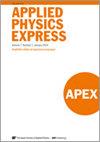β-Ga2O3微线中随温度变化的拉曼主动声子模式和电子-声子耦合
IF 2.2
4区 物理与天体物理
Q3 PHYSICS, APPLIED
引用次数: 0
摘要
系统地研究了β-Ga2O3微线中的晶格振动和电子-声子耦合。(020)取向的β-Ga2O3微丝有14个拉曼峰,其中所有的半峰全宽(FWHM)都比(100)取向的β-Ga2O3体单晶窄。当温度从80K升高到300K时,大多数拉曼有源声子模式发生蓝移,少数模式先蓝移后红移。β-Ga2O3微丝的光致发光主要来源于自俘获激子(STE)的重组,定量分析表明β-Ga2O3微丝中存在较强的EPC, Huang-Rhys因子高达S′≈14。本文章由计算机程序翻译,如有差异,请以英文原文为准。
Temperature-dependent Raman-active phonon modes and Electron−Phonon Coupling in β-Ga2O3 microwire
The lattice vibration and electron-phonon coupling (EPC) in β-Ga2O3 microwire are systematically investigated. The β-Ga2O3 microwire that is (020)-oriented shows 14 Raman peaks, with all the full width at half maximum (FWHM) of them narrower than those of (100)-oriented β-Ga2O3 bulk single crystal. As the temperature increases from 80K to 300K, most Raman-active phonon modes are blueshifted, while a few modes are first blueshifted and then redshifted. The photoluminescence mainly originates from the recombination of self-trapping exciton (STE) and the quantitative analysis reveals that there exists quite strong EPC in β-Ga2O3 microwire and the Huang-Rhys factor is up to Sʹ≈14.
求助全文
通过发布文献求助,成功后即可免费获取论文全文。
去求助
来源期刊

Applied Physics Express
物理-物理:应用
CiteScore
4.80
自引率
8.70%
发文量
310
审稿时长
1.2 months
期刊介绍:
Applied Physics Express (APEX) is a letters journal devoted solely to rapid dissemination of up-to-date and concise reports on new findings in applied physics. The motto of APEX is high scientific quality and prompt publication. APEX is a sister journal of the Japanese Journal of Applied Physics (JJAP) and is published by IOP Publishing Ltd on behalf of the Japan Society of Applied Physics (JSAP).
 求助内容:
求助内容: 应助结果提醒方式:
应助结果提醒方式:


